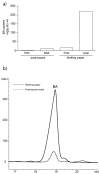Bryonolic acid: a large-scale isolation and evaluation of heme oxygenase 1 expression in activated macrophages
- PMID: 20481554
- PMCID: PMC2905313
- DOI: 10.1021/np1000076
Bryonolic acid: a large-scale isolation and evaluation of heme oxygenase 1 expression in activated macrophages
Abstract
Bryonolic acid (BA) is a triterpenoid found in the Cucurbitaceae family of plants. Our interests in the immunomodulatory effects of this class of natural products led us to discover that BA induces a marked increase in the expression of a phase 2 response enzyme, heme oxygenase 1 (HO-1), in a dose-dependent manner. This phenotype has translational implications in malarial disease progression, and consequently we developed a large-scale isolation method for BA that will enable future in vitro and in vivo analyses. We have determined ideal growth conditions and time scale for maximizing BA content in the roots of Cucurbita pepo and analyzed BA production by HPLC. Large-scale extraction yielded 1.34% BA based on dry weight, allowing for the isolation of BA on a multigram scale.
Figures





Similar articles
-
Bryonolic acid transcriptional control of anti-inflammatory and antioxidant genes in macrophages in vitro and in vivo.J Nat Prod. 2012 Apr 27;75(4):591-8. doi: 10.1021/np200823p. Epub 2012 Feb 16. J Nat Prod. 2012. PMID: 22339499 Free PMC article.
-
Anti-Inflammatory Effects and Mechanisms of Action of Coussaric and Betulinic Acids Isolated from Diospyros kaki in Lipopolysaccharide-Stimulated RAW 264.7 Macrophages.Molecules. 2016 Sep 9;21(9):1206. doi: 10.3390/molecules21091206. Molecules. 2016. PMID: 27618005 Free PMC article.
-
Eight new cucurbitane triterpenoids from "Xue Dan," the roots of Hemsleya pengxianensis.J Asian Nat Prod Res. 2018 Jan;20(1):36-48. doi: 10.1080/10286020.2017.1355363. Epub 2017 Sep 20. J Asian Nat Prod Res. 2018. PMID: 28929786
-
Modulation of the monocyte/macrophage system in heart failure by targeting heme oxygenase-1.Vascul Pharmacol. 2019 Jan;112:79-90. doi: 10.1016/j.vph.2018.08.011. Epub 2018 Sep 10. Vascul Pharmacol. 2019. PMID: 30213580 Review.
-
Heme oxygenase and renal disease.Curr Hypertens Rep. 2009 Feb;11(1):56-62. doi: 10.1007/s11906-009-0011-z. Curr Hypertens Rep. 2009. PMID: 19146802 Review.
Cited by
-
Bryonolic Acid, a Triterpenoid, Protect Against N-methyl-d-Aspartate-Induced Neurotoxicity in PC12 Cells.Molecules. 2016 Mar 28;21(4):418. doi: 10.3390/molecules21040418. Molecules. 2016. PMID: 27043504 Free PMC article.
-
Molecular library synthesis using complex substrates: expanding the framework of triterpenoids.J Org Chem. 2013 Jan 18;78(2):410-8. doi: 10.1021/jo302211f. Epub 2013 Jan 10. J Org Chem. 2013. PMID: 23245400 Free PMC article.
-
Enhanced Production of Bryonolic Acid in Trichosanthes cucumerina L. (Thai Cultivar) Cell Cultures by Elicitors and Their Biological Activities.Plants (Basel). 2020 Jun 2;9(6):709. doi: 10.3390/plants9060709. Plants (Basel). 2020. PMID: 32498354 Free PMC article.
-
Bryonolic acid transcriptional control of anti-inflammatory and antioxidant genes in macrophages in vitro and in vivo.J Nat Prod. 2012 Apr 27;75(4):591-8. doi: 10.1021/np200823p. Epub 2012 Feb 16. J Nat Prod. 2012. PMID: 22339499 Free PMC article.
-
The effects of methanolic, chloroform, and ethylacetate extracts of the Cucurbita pepo L. on the delay type hypersensitivity and antibody production.Res Pharm Sci. 2012 Oct;7(4):217-24. Res Pharm Sci. 2012. PMID: 23248672 Free PMC article.
References
-
- Biglino G. Ann Chim. 1959;49:782–92.
-
- Sim KY, Lee HT. Phytochemistry. 1972;11:3341–3.
-
- Dayal R, Dobhal PC. J Med Aromat Plant Sci. 2001;23:660–661.
-
- Biglino G, Cattel L, Caputo O. Ricerca Scientifica. 1969;39:207–9. - PubMed
-
- Tanaka S, Uno C, Akimoto M, Tabata M, Honda C, Kamisako W. Planta Med. 1991;57:527–30. - PubMed
Publication types
MeSH terms
Substances
Grants and funding
LinkOut - more resources
Full Text Sources
Other Literature Sources

